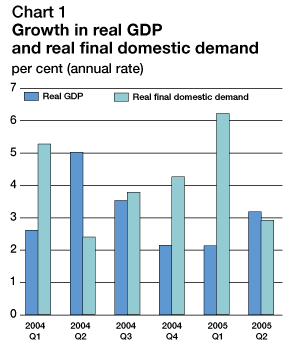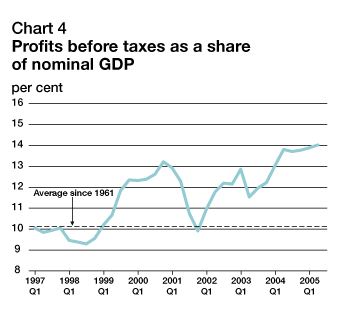|
|
The Economy in Brief
September 2005
Overview
|
Real GDP grows 3.2%
Real GDP rose 3.2% in the second quarter. Final domestic demand growth remained solid and was met by increased domestic output as real imports fell (Chart 1).

Consumer spending growth eases
Real consumer expenditure grew 2.4% in the second quarter, down from the first-quarter pace of 6.7%. Consumption of durables, semi-durables and services all showed slower growth than in the previous quarter while spending on non-durables declined.
Main economic indicators
(per cent change at annual rates unless otherwise indicated)
|
|
|||||||
|---|---|---|---|---|---|---|---|
| 2003 | 2004 | 2004:Q4 | 2005:Q1 | 2005:Q2 | Most recent | ||
|
|
|||||||
| Real gross domestic product | 2.0 | 2.9 | 2.1 | 2.1 | 3.2 | – | |
| Final domestic demand | 3.6 | 3.9 | 4.3 | 6.2 | 2.9 | – | |
| Government expenditure | – | ||||||
| Goods and services | 2.9 | 2.7 | 2.1 | 3.6 | 3.1 | – | |
| Gross fixed capital | 4.5 | 4.9 | 3.6 | 6.4 | -1.7 | – | |
| Consumer expenditure | 3.1 | 3.4 | 3.8 | 6.7 | 2.4 | – | |
| Residential investment | 6.2 | 8.3 | 5.2 | -1.5 | 7.9 | – | |
| Business fixed investment | 6.1 | 6.1 | 9.9 | 13.5 | 3.5 | – | |
| Non-residential construction | 5.7 | 0.8 | 0.9 | 13.1 | 4.1 | – | |
| Machinery and equipment | 6.4 | 9.8 | 16.5 | 13.7 | 3.2 | – | |
| Business inventory investment ($ billion) | 11.1 | 11.5 | 22.6 | 15.3 | 11.3 | – | |
| Exports | -2.1 | 5.0 | -3.1 | 5.5 | 0.8 | – | |
| Imports | 4.1 | 8.1 | 8.3 | 11.0 | -3.5 | – | |
| Current account balance | |||||||
| (nominal $ billion) | 18.4 | 28.8 | 21.1 | 13.5 | 18.7 | – | |
| (percentage of GDP) | 1.5 | 2.2 | 1.6 | 1.0 | 1.4 | – | |
| Nominal personal income | 3.4 | 4.3 | 4.5 | 3.6 | 6.0 | – | |
| Nominal personal disposable income | 3.7 | 3.9 | 3.5 | 2.2 | 4.3 | – | |
| Real personal disposable income | 2.1 | 2.5 | 2.1 | 1.0 | 2.3 | – | |
| Profits before taxes | 8.7 | 18.7 | 6.1 | 7.0 | 9.5 | – | |
| Costs and prices (%, y/y) | |||||||
| GDP price deflator | 3.3 | 3.0 | 3.5 | 2.9 | 2.2 | – | |
| Consumer Price Index | 2.8 | 1.9 | 2.3 | 2.1 | 1.9 | 2.0 | Jul-2005 |
| CPI excluding eight most volatile items |
2.2 | 1.5 | 1.6 | 1.8 | 1.6 | 1.4 | Jul-2005 |
| Unit labour costs | 2.1 | 1.1 | 0.7 | 1.0 | 1.7 | ||
| Wage settlements (total) | 2.6 | 1.8 | 2.2 | 2.6 | 2.6 | 2.7 | Jun-2005 |
| Labour market | |||||||
| Unemployment rate (%) | 7.6 | 7.2 | 7.1 | 7.0 | 6.8 | 6.8 | Aug-2005 |
| Employment growth | 2.3 | 1.8 | 1.7 | 0.6 | 1.7 | 0.7 | Aug-2005 |
| Financial markets (average) | |||||||
| Exchange rate (cents U.S.) | 71.6 | 77.0 | 81.9 | 81.5 | 80.4 | 84.93 | 09-Sep-05 |
| Prime interest rate (%) | 4.7 | 4.0 | 4.3 | 4.3 | 4.3 | 4.50 | 09-Sep-05 |
|
|
|||||||
| Note: Real values are in chained 1997
dollars. Sources: Statistics Canada, the Bank of Canada and Human Resources and Skills Development Canada. |
|||||||
Personal income registered a 6.0% gain in the second quarter following a 3.6% gain in the first. Labour income rose 6.2% as employment and average hours worked per employee increased faster than in the previous quarter. Real personal disposable income climbed for the seventh consecutive quarter, rising 2.3% following a 1.0% gain in the previous quarter. Real personal disposable income per capita increased 1.5% and stood more than 16% above its recent trough in the second quarter of 1996. For the second consecutive quarter, consumers spent more than their disposable income.
Residential investment bounces back
Residential investment increased 7.9% in the second quarter after declining 1.5% in the first. Low interest rates continued to support housing activity as housing starts increased, edging up new construction activity by 0.5% after a first-quarter drop of 6.0%. Renovations climbed more quickly than in the previous quarter. Housing resale activity produced a large gain in real estate transfer costs.
Business fixed investment rises
Supported by low interest rates and record profits, business spending on plant and equipment registered a 10th consecutive increase in the second quarter, growing 3.5% after a 13.5% first-quarter gain. Investment in machinery and equipment rose 3.2%, after a 13.7% jump in the previous quarter.
Non-residential construction increased 4.1% after a strong first-quarter gain. For the second consecutive quarter, both building construction, such as office towers and shopping malls, and engineering projects contributed to growth.
Business inventory accumulation slows
Businesses increased inventories by $11.3 billion in the second quarter, $3.9 billion less than in the first quarter. The slowdown in the second quarter was concentrated in manufacturing industries. The inventory-to-sales ratio remained low by historical standards.
Exports rise
Exports increased 0.8% in the second quarter, slowing from a 5.5% rise in the first (Chart 2). Within goods, strong U.S. growth in investment in computers and software helped boost machinery and equipment exports, especially information and communications technology equipment. This gain was largely offset by sharp declines in exports of automotive and energy products, with exports of cars plunging as increased sales in the United States were partly met by a reduction of inventories in that country. Exports of services increased 4.1%.

Imports decline
Real imports registered their first decline after six consecutive gains, dropping 3.5%. The decrease was broadly based, with energy and industrial products falling sharply. Imports of automotive products inched lower as imported parts, used in the production of vehicles, declined with falling automotive exports. Investment growth, however, boosted machinery and equipment imports by 7.0%, the ninth consecutive increase. Imports of services increased 2.5%.
Current account surplus widens
In the second quarter, the current account registered its 24th consecutive surplus, in contrast with deficits throughout most of the 1980s and 1990s. The surplus widened to $18.7 billion or 1.4% of nominal GDP from $13.5 billion in the previous quarter (Chart 3). With real exports rising and real imports falling, the nominal goods trade surplus grew by over $5 billion. However, a jump in dividend payments to non-residents contributed to a worsening in the investment income deficit, moderating the current account’s improvement.

Corporate profits grow again
Corporate profits rose 9.5% in the second quarter, up from the 7.0% first-quarter pace. A strong upward trend in profits has raised their share of GDP to a record 14.0%, well above the 10.1% historical average since 1961 (Chart 4). Non-financial enterprises reported gains, with oil and gas producers and other mining companies benefiting from high commodity prices.

Consumer price inflation remains low
The GDP deflator, a comprehensive measure of prices, rose 2.0% in the second quarter to stand 2.2% higher than a year earlier.
Year-over-year consumer price inflation stood at 2.0% in July, up from 1.7% in June, as gasoline and natural gas prices rose. At 1.4% in July, core CPI inflation, which excludes the eight most volatile items, sat below the mid-point of the 1% to 3% target band.
Unemployment rate remains near its low
Employment grew 1.7% in the second quarter, and another 33,400 jobs were added in July and August. Since the end of 2004 the Canadian economy has created 137,600 net new jobs, all of them full-time. The participation rate sat at 67.2% in August, the same as in June and July, but down slightly from May and from its record high of 67.7% first set in late 2003 and matched several times since. As in July, the unemployment rate sat at 6.8% in August, up from 6.7% in June, when it matched the low of early 1976.
Hourly labour productivity remained unchanged in the second quarter from its first-quarter value as growth in hours worked matched that in output. This followed a 0.7% rise in output per hour worked in the first quarter and a 2.5% jump in the fourth quarter of 2004. Labour costs per unit of output rose 2.9% in the second quarter to stand 1.7% higher than a year earlier.
Bank of Canada raises policy rate
On September 7, the Bank of Canada raised its key policy rate—the target for the overnight rate—by one quarter of a percentage point to 2.75 per cent, the first increase since October 2004. The Bank stated that with "the economy operating close to full capacity" the "interest rate increase will help to promote a balance between aggregate demand and supply in the economy and keep inflation on target over the medium term."
The U.S. Federal Reserve has raised its target rate 10 times from 1.00% in June 2004 to 3.50% in August 2005. U.S. interest rates at all maturities are higher than those in Canada.
The Canadian dollar eased from a nearly 13-year high of 85.04 cents U.S. on November 26, 2004, to close as low as 78.77 cents U.S. on May 16, 2005, but has rebounded along with rising commodity prices. The dollar closed at 84.93 cents U.S. on September 9, 2005.
Note: Unless otherwise noted, data and per cent changes are quoted at annual rates. The cut-off date for data is end of day, September 9, 2005.
The main source of data used in this publication is Statistics Canada.
Subscription inquiries should be directed to the Distribution Centre at
(613) 995-2855.
For other inquiries about this publication, contact Steven James at
(613) 992-4321.
| Last Updated: 2005-09-26 | |||||